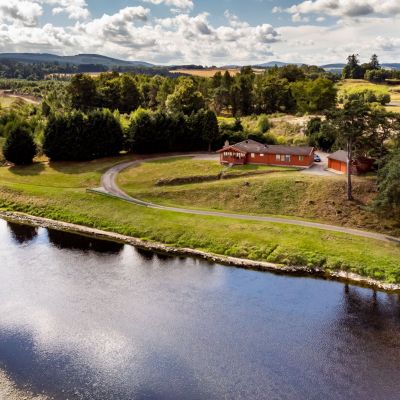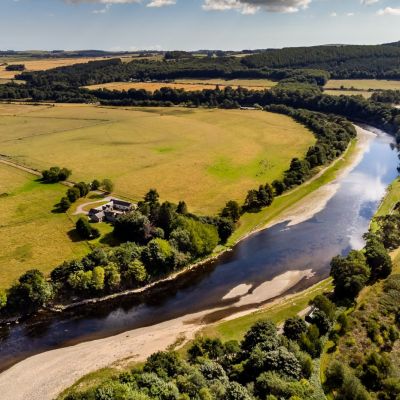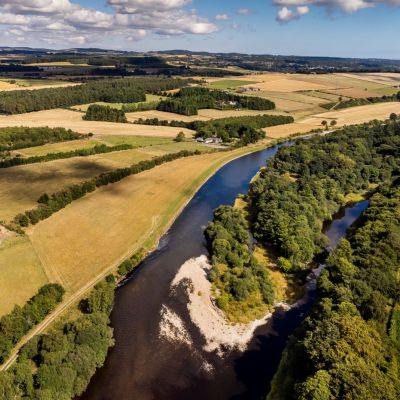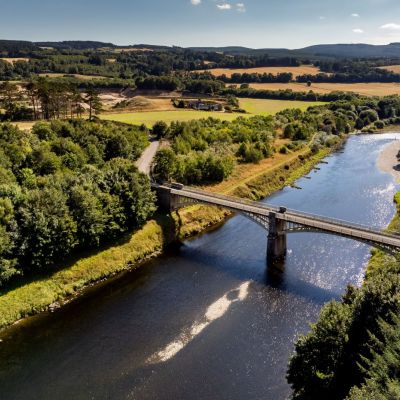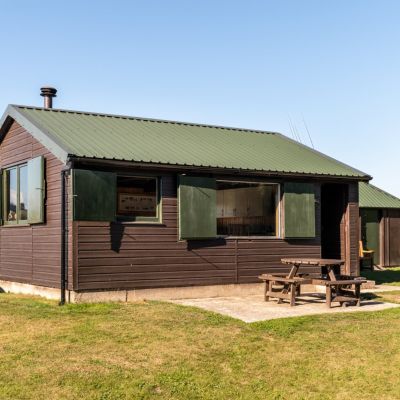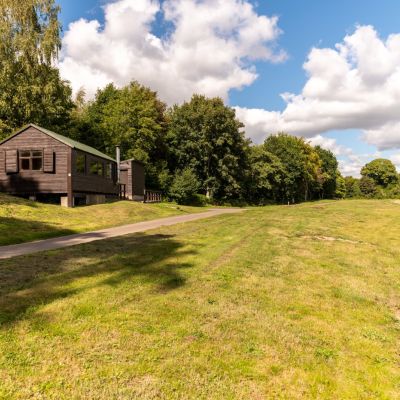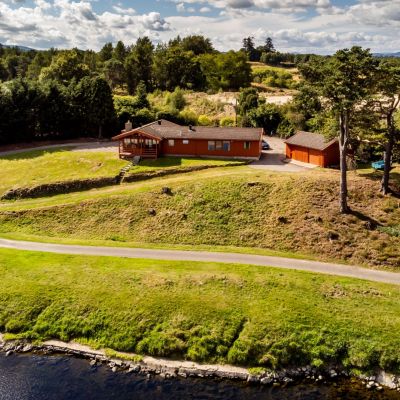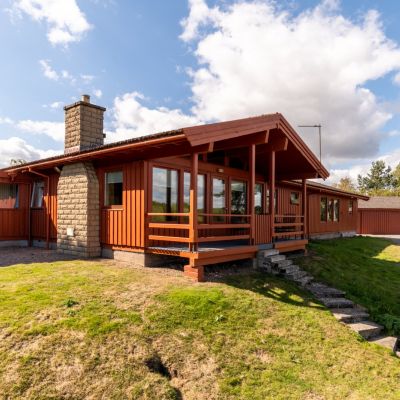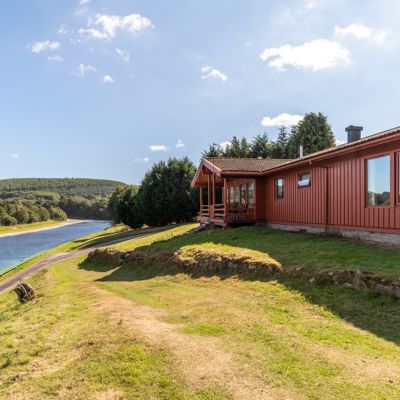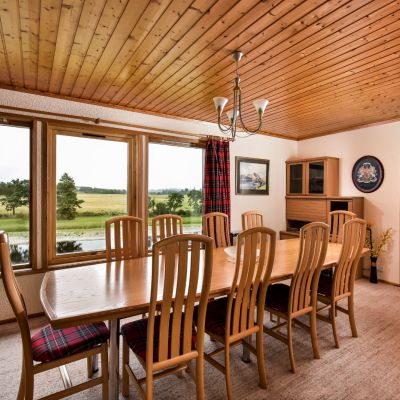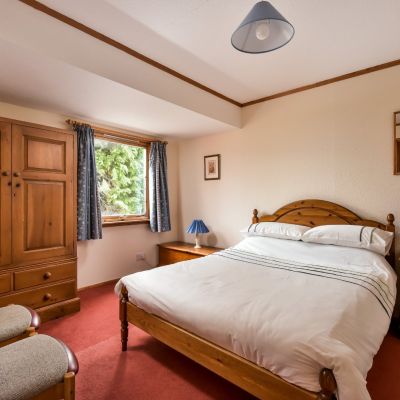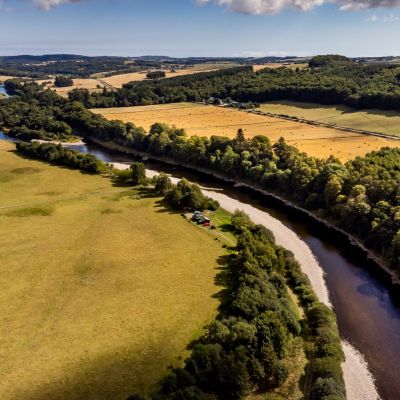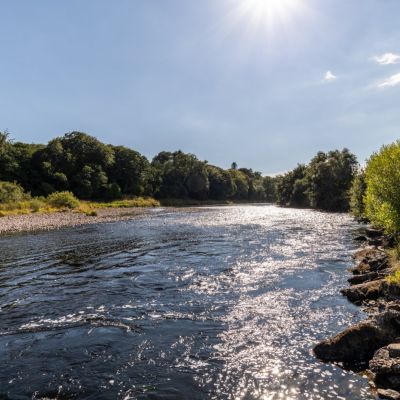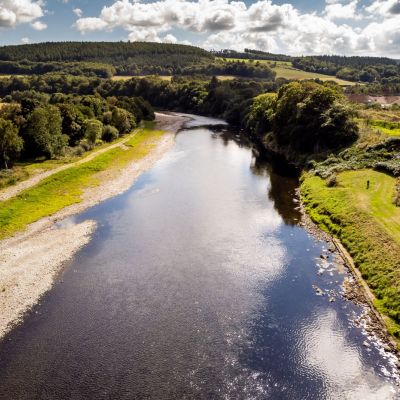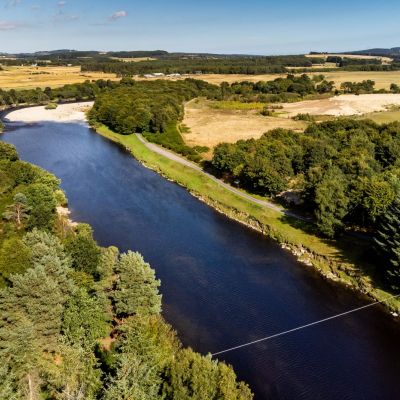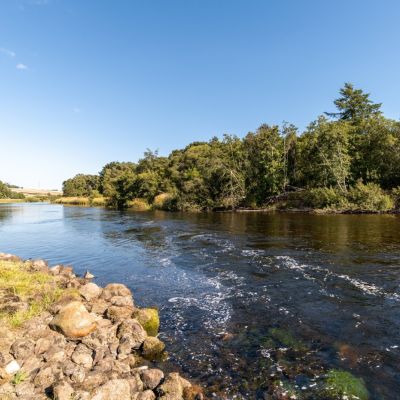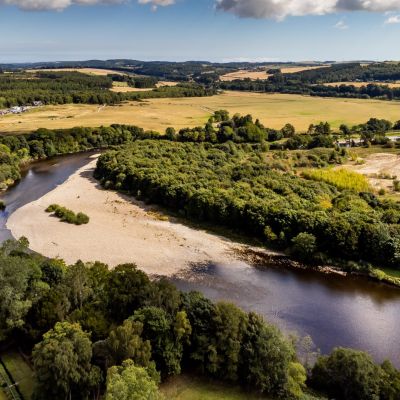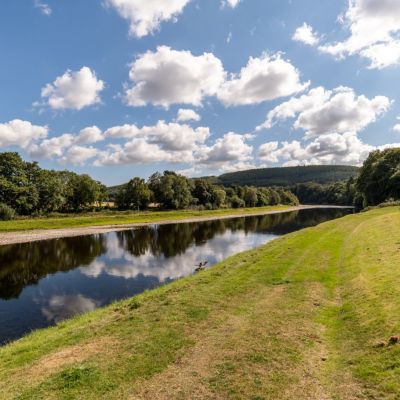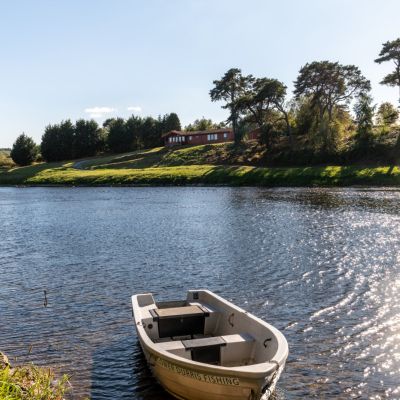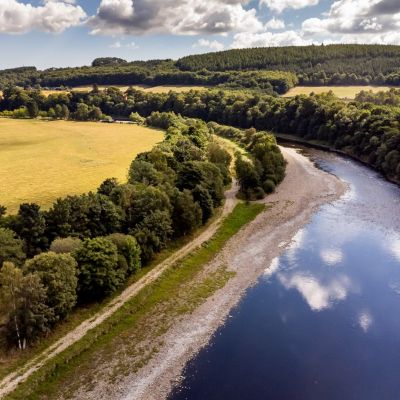Kincardine AB13 River Dee
- Offers Over
- £800,000
A riverside dwelling and extensive amenity woodlands, together with a magnificent beat of salmon fishings on Scotland's famous River Dee | 11 named pools and fishing for up to 6 rods | 2 fishing huts | extensive natural capital.
Features:
A comfortably appointed and privately situated residential lodge overlooking the River Dee with approximately 1,917 square feet of internal accommodation including 2 reception rooms, 6 bedrooms and 3 bathrooms.
Useful outbuildings including garage and general store/rod room.
About 1.3 miles of double and 0.3 mile of single (right) bank salmon and sea trout fishings on one of the most historically productive beats of salmon fishing on the River Dee with 11 named pools.
A beautifully maintained and historically productive beat (10-year average of 258 salmon/grilse and 65 sea trout to 1999) which has been lightly fished in recent years (10-year average of 76 salmon/grilse and 14 sea trout to 2021).
Fishing for up to 6 rods with notably easy wading throughout (the beat is affectionately known as the ‘carpet slipper’ beat).
Excellent vehicular and pedestrian access, two well-equipped fishing huts plus associated stores and a boat to enable easy access to either bank.
Full-time and highly regarded ghillie with a combination of excellent experience of the beat and enthusiastic vision for its future.
Ownership of the riverbanks and alveus (river bed) on both banks including well-managed stands of mixed-species woodland with possibilities for the development of leisure facilities including cabins, chalets, glamping pods or similar subject to the necessary consents.
Access for kayaking, canoeing, paddle boarding, rafting and wild swimming.
Extensive wildlife and natural capital including otters, ospreys, kingfishers, wagtails, dippers and a host of other native species of flora and fauna.
Description:
Situated in a tranquil part of the lower course of Aberdeenshire’s River Dee, the subjects of sale combine a well-appointed residential property with ownership of one of the lesser known but traditionally most productive beats of salmon and sea trout fishing on this world-renowned salmon river.
With the Park beat lying immediately upstream and both Tilbouries and also Altries and Lower Drum lying immediately downstream, the Upper Drum and Lower Durris Beats are similarly productive in historical terms yet lesser known amongst salmon anglers on account of having been fished lightly and only on a quasicommercial basis during the 23-year period of the current ownership.
The availability of the beats for sale combined with a modernised 6-bedroom fishing lodge and over 87 acres of river bed (alveus), riverbanks and adjoining grassland and woodland provides a special opportunity for purchasers to buy a stake in the ownership of one of Europe’s most famous salmon rivers which also represents a thriving riverine ecosystem supporting healthy populations of a variety of rare and protected species alongside the Atlantic Salmon for which the river has achieved its historic renown.
The River Dee:
With a catchment area of 810 square miles, the Dee is regarded as one of Scotland’s ‘Big four’ salmon rivers along with the Tweed, Tay and Spey. The character of the river makes it ideal for fly fishing. The fast flowing, crystal clear waters are home to a succession of salmon pools that provide the angler with some of the finest fly water in Europe.
The river rises from a spring on the Braeriach plateau in the Cairngorm Mountains at a height of about 4,000 feet, the highest source of any major river in the UK. Emerging in a number of pools called the Wells of Dee, the young Dee then flows across the plateau to the cliff edge from where the Falls of Dee plunge into An Garbh Choire (“burn of the rough corrie”). The river is then joined by a tributary coming from the Pools of Dee in the Lairig Ghru, and flows south down the Lairig Ghru between Ben Macdui and Cairn Toul, tumbling over falls in the Chest of Dee on its way to White Bridge and the confluence with the Geldie Burn, at which point it turns east.
After passing through the spectacular Linn of Dee a few miles west of Braemar, the river then flows through Strathdee and ‘Royal Deeside’ passing through or by the villages of Braemar, Ballater, Aboyne, Dinnet and Kincardine O’ Neil before reaching Banchory where it enters its lower course where Upper Drum and Lower Durris is situated.
With regard to its fishing, this part of the river is traditionally best for early spring salmon and also late summer and autumn fish. In a cold winter, salmon tend to migrate upstream slowly in the early months of the season. Fish pass through the lower beats throughout the season and build in numbers from July to the season end. Sea trout provide their unique brand of excitement during May and June, particularly at night.
August and September can provide some of the most exciting sport of the year as grilse, big late summer and autumn fish arrive.
Atlantic Salmon (Salmo Salar) is the dominant fish species on the Dee. There are also significant numbers of brown trout, generating a sea trout run and supporting a small sea trout fishery. There are also pike and perch present in the few lochs on the system together with eels, lampreys (sea, river and brook species), flounder and stickleback.
Much of the semi-natural Caledonian pine forest in Scotland is within the Dee catchment. The area contains nationally rare examples of pine woods, birch woods and heather moors with associated wildlife. On the valley floor there are deciduous alder and mixed broadleaved woods, and meadow grasslands.
The River Dee’s designation as a European Special Area of Conservation (SAC) is partly in recognition of the importance of the salmon population (as well as pearl mussels and otters). The Dee District Salmon Fishery Board (the statutory body tasked with protecting and enhancing stocks of salmon and sea trout throughout the Dee system) is a competent authority under the EU Habitats and Species Directive in terms of the Atlantic salmon component of the Special Area of Conservation designation on the Dee.
The River Dee fishing season runs from 1 February to 15 October each year. Under Marine Scotland’s Atlantic Salmon Conservation Policy, the entirety of the River Dee system is in grade 3 in 2022 (with no change proposed for 2023); the effect of which is that a mandatory catch and release policy is in operation at all times throughout the system.
The Upper Drum and Lower Durris Salmon Fishings:
Providing 1.3 miles of double bank fishing together with 0.3 mile of single (right) bank salmon and sea trout fishing on the Lower River, the Upper Drum and Lower Durris beats provide fishing for up to 6 rods over 11 pools of classic fly water in a peaceful and secluded setting with easy accessibility.
From an angling perspective, the ambience of riverbank and the hypnotic flow of the stream make these beats an ideal ‘escape from reality’ for the lone fisherman, a group of friends or a corporate party – whether seasoned anglers or complete beginners.
With a gently meandering course and river bed comprising mainly relatively fine shingle, Upper Drum and Lower Durris has earned the moniker ‘the carpet slipper beat’ on the basis that access to the river itself and the wading through each of the pools is so straightforward and gentle compared to the rockier based beats of further upstream on the Dee and on other rivers.
With pools that contrast in depth and character, the beat can be productively fished in all heights of water.
Purchased by the family of the current owners in 1999, the beat has been operated by them as a private fishery with very limited commercial letting of the fishing.
Riverside Lodge:
Situated on the right bank of the river on the Lower Durris side of the beat, Riverside Lodge is a chalet-style dwelling of timber frame and pine clad construction which occupies an elevated position overlooking the Lodge pool – historically one of the most productive on the beat.
Approached via a gated private drive which leads for about three quarters of a mile from the minor public road to the south of Park Bridge and runs parallel with the right (south) bank of the river, Riverside Lodge was originally constructed in the mid 1980s but has been modernised and improved during the vendors’ ownership.
Built to provide on-site accommodation for parties of anglers, the internal accommodation extends to about 1,917 square feet of gross internal area which includes 2 spacious reception rooms, a kitchen, 6 bedrooms (including master bedroom with en-suite bathroom) and 3 bath/shower rooms (inclusive of the en-suite bathroom).
Modernised to a high standard which includes triple glazing throughout, well-maintained and occupied sparingly during the last 20 years, the lodge offers purchasers the opportunity to either continue to occupy the property as holiday accommodation (either in conjunction with, or independently of the salmon fishings) or as a permanent home.
The building is served by mains water and electricity with bottled gas cooking facilities and private drainage to a septic tank.
The layout of the accommodation is as shown on the floor plans within the sales brochure.
Detached from Riverside Lodge but lying close beside it is a further building incorporating a garage and general store used as rod room and for tackle/general equipment storage.
The Fishing:
The extent of the beat together with the position and names of each the principal pools is shown on the sale plan included within the particulars of sale.
Across the beat, there is a variety of fishing from the north and south banks, with each of the 11 named pools being easily accessible and providing comfortable fishing both from the bank and by wading.
In good water conditions, anglers typically favour 13 to 15 feet double-handed fly rods to cover the pools effectively in most water conditions, whilst an 11 to 12-foot rod is adequate to cover the pools in the lower levels of water with some anglers favouring single-handed rods at 9 to 10 feet in length to maximise the excitement of playing a lively grilse or sea trout.
Fishing Records:
At the time of the vendors’ family’s purchase of the beats in 1999, the recorded 10-year average catches for the beat were 258 salmon/grilse and 65 sea trout.
Whilst average catch records on most Dee beats in 2022 are substantially lower than in the late 1990s, the recorded catches for Upper Drum and Lower Durris have been additionally impacted by modest fishing effort in recent years including limited commercial lettings. Accordingly, it is considered that the current 5-year average of 53 salmon/grilse and 11 sea trout is not an accurate representation of the potential productivity of the beat in the event of it having been more fully fished during this period.
The recorded annual average catch records for the beat for the last 10 years are detailed in the sales brochure.
Fishing Huts:
There are two fishing huts serving the beat located on both the north and south bank with vehicular access and ample parking for several cars beside each hut. In excellent condition having been well-maintained during the current ownership, each hut provides spacious accommodation for dining and sheltering from the weather with both being served by fitted kitchens with running water and cooking facilities together with WCs.
Riverbanks and Access:
The subjects of sale include ownership of the riverbank and alveus (river bed) for about 1.3 miles of the south (right) bank, and about 0.3 mile of the north (left) bank as shown on the plan of the beat accompanying these particulars of sale.
The principal route of vehicular access to Riverside Lodge and the Lower Durris (south) bank is entirely within the ownership of the vendors and leads directly from the minor public road to Park Bridge from the B9077. There is an additional right of vehicular access over a track leading to the downstream end of the beat.
Vehicular access to the Upper Drum (north) bank is by means of a vehicular track (passable by two-wheel drive vehicle) which leads through Dalmaik Farm which adjoins the beat and is independently owned. The vendors benefit from a Servitude right of vehicular access over this track with its route marked on the plan of the beat within these particulars.
There are footpaths following both banks which enable straightforward access throughout the beats and to each of the pools.
Ghillie:
A ghillie is employed on a full-time basis. He lives off the property. An enthusiastic and capable angling guide who can also offer casting tuition, the Upper Drum and Lower Durris ghillie is highly regarded by the vendors and it is their firm preference that the purchaser continues his employment under Transfer of Undertakings (Protection of Employment) legislation.
Land:
The total extent of subjects offered for sale at Upper Drum and Lower Durris extends to about 87 acres in total which is inclusive of the river bed and banks together with the footprint of the Lodge, fishing huts and their surrounding parking area.
Included within this are about 28 acres of mixed species woodland lying mainly on the Lower Durris (south) bank of the beat. Having been carefully brashed and thinned for the purposes of both woodland management and presentation of the beat, the woods lend privacy and ambience to the beat and are a particular feature of it.
Leisure and Amenity:
The extent of land and woodland within the subjects of sale together with the quality of vehicular access (particularly on the Lower Durris bank) provides the opportunity for purchasers looking to explore the commercial potential of the property and its setting to erect chalets, cabins, glamping pods or other similar forms of temporary accommodation subject to the appropriate consents.
The wildlife of the river and its banks includes some of the UK’s rarest species of fish, bird, mammal and mollusc and there may be a commercial opportunity to be explored in presenting these attractions and encouraging access to and presentation of them to the tourism market beyond conventional salmon anglers.
Water sports in the form of kayaking, canoeing, paddle boarding and inflatable rafting are an increasing feature of the River Dee where responsible access to the river is granted in favour of the general public in Scotland by law.
There is a generally respectful interaction between canoeists and rafters and anglers which enables both to enjoy their chosen pastime without disturbance by the other.
Current and Future Management:
Current management of the beat provides fishing for up to 6 rods, but the vendors have not sought to maximise either the beat of salmon fishings or Riverside Lodge on a commercial basis.
The future management of the beat is entirely at the discretion of the purchaser. This could focus on purely on offering salmon fishings for let as at present and/or could explore alternative opportunities for revenue which make use of the boats and the huts on the beat and provide alternative forms of customer experience which showcases the wider attractions of the River Dee’s habitat, wildlife and natural capital.
The Dee District Salmon Fishery Board:
The Dee District Salmon Fishery Board (DDSFB) is the statutory body tasked with protecting and enhancing stocks of salmon and sea trout across the district. The district encompasses not only the River Dee but also the neighbouring rivers of the Carron and Cowie.
This Board has been recognised as being at the forefront of fisheries management in Scotland with an established track record in innovative conservation and enhancement policies.
Proprietors of beats on the River Dee pay an annual levy in return for services provided by the DDSFB in conducting research and carrying out conservation and protection of the Dee system in its entirety.
The gross amount payable to the DDSFB in 2022 for the Upper Drum and Lower Durris fishings is £14,831.80 in total.
In addition, Riverside Lodge and the two fishing huts are assessed for non-domestic Rates. The rateable value for the year to 31 March 2023 is £3,200 at a basic property rate of £0.498. The application of Small Business Bonus Relief reduces the amount payable in 2022/23 to zero.
Environmental Designations:
The entirety of the River Dee is designated as a Special Area of Conservation (SAC).
This property has 87 acres of land.
Situation
Situation:
Riverside Lodge and the Upper Drum and Lower Durris Beat of salmon fishings is located in the valley of the lower River Dee about 8 miles east of Banchory and a short distance from the village of Drumoak which lies on the north side of the river. Occupying the majority of 1.6 miles of both banks of the river, there is vehicular access to both the north and south banks with Riverside Lodge lying on the south bank facing east and overlooking the Lodge Pool.
Access to the south bank (Riverside Lodge and the Lower Durris beat) is directly off the minor public road which leads from the B9077 (South Deeside Road) towards Drumoak village via Park Bridge (currently closed).
Access to the north bank (The Upper Drum beat) is via minor public roads and a private vehicular access track (over which the vendors have a formal right of servitude) which connect to the A93 Aberdeen to Banchory road just east of Drumoak.
Lying 8 miles west and a 10-minute drive from Riverside Lodge and the Upper Drum and Lower Durris beats, Banchory is the nearest town of note. Serving as both a commuter town and local centre of commerce, Banchory is known as ‘the gateway to Royal Deeside’. The range of shops, services and facilities, includes a supermarket, various High Street retailers, a GP medical practice and both primary and secondary schools.
Comprehensive services are available in Aberdeen which provides a range of administrative, retail, recreational, educational and cultural facilities. Aberdeen city centre is 12 miles from Riverside Lodge and the beats whilst Aberdeen international airport is 18 miles and can be reached in about 25 minutes by car (under normal traffic conditions) via the recently built A90 Aberdeen bypass which is just 3 miles from Upper Drum and Lower Durris.
The wider county of Aberdeenshire which incorporates the eastern half of the Cairngorms National Park offers a wealth of activities, including fishing, sporting, whisky tasting, golf, winter sports, walking, climbing and cycling.
There are a number of renowned golf courses on the North Sea coast at Royal Aberdeen, Cruden Bay and the Trump International Golf Links. More locally, there are enjoyable 18-hole parkland courses at Banchory and Peterculter together with a 9-hole course at the Paul Lawrie Golf Centre near Peterculter.
For many, the Grampian foothills of Aberdeenshire and the adjoining county of Moray are synonymous with Whisky – and Malt Whisky in particular. Both counties are home to historic and famous distilleries, coopers, bottlers and retailers contributing to an industry which is said to be worth about £5.5 billion to the Scottish economy annually. The Malt Whisky Trail is a collaboration of distilleries offering enthusiasts the opportunity to visit nine local distilleries in order to meet those who play key roles in this multinational industry. It is popular with tourists and adds significantly to the variety of activities available within striking range of Upper Drum and Lower Durris.
Directions
Directions:
From the A90 Aberdeen bypass, follow signs to the B9077 South Deeside road.
Lying 3 miles west of the A90 is a right hand turn on to a minor public road signposted to Drumoak. This leads to the Park Bridge which is currently closed. The entrance gates to Riverside Lodge and the Lower Durris bank are on the right hand side just before reaching the bridge.
For navigational purposes – what3words - //Beams.Inspects.Answers.
Read more- Map & Street View































